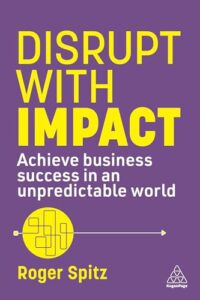Packed with practical and realistic advice that is presented in a conversational and approachable style, Roger Spitz’s Disrupt with Impact: Achieve Business Success in an Unpredictable World offers a workable roadmap for those seeking to both futureproof their business against disruptions and leverage those inevitable disruptions to secure growth and a competitive advantage. Seeking to motivate readers and equip them with the tools necessary for success in an ever-changing business environment, Spitz presents a step-by-step approach to embracing and driving the kinds of changes that a business requires in order to thrive.
To accomplish this, Spitz begins by examining the concept of disruption, its existence throughout history, and the nature of the disruption-related situation today. For instance, among the disruptive changes that have faced humanity in recent decades are the rapid growth of online commerce, the global financial crisis, climate change, and the COVID-19 pandemic, all of which have led to opportunities and setbacks for businesses. While the historical analysis is interesting and informative, the suggestions regarding scanning the horizon for likely changes and the adoption of a mindset that is capable of taking advantage of disruption and/or overcoming the challenges associated with it are particularly helpful, having practical significance in all fields.
Building on the first section, Spitz then turns his attention to how readers can foster system-level changes that accrue real benefits for their business. He relates key business concepts such as value creation, continuous improvement, and feasible strategy building to the issues posed by disruption, both the good and the bad. The emphasis on the sustainability of change accords with modern green sensibilities and suggests the evergreen nature of Spitz’s recommendations. The same is true of the focus on leveraging the wide-ranging opportunities available in the contemporary business world, including the unprecedented level of funding sources and avenues for collaborative work.
In the third section, Spitz speculates on the future of artificial intelligence (AI) in the business context and how it will impact both planning and decision making. Here, he makes informed predictions about the technologies that will prove particularly useful for businesses in the coming years, covering a variety of time horizons. Unsurprisingly, the likely development directions of AI are a major focus, as are the various ways such technology can enhance or threaten a business. Although Spitz includes several notes of caution, including suggesting ways to stay relevant in the age of exponential AI development, it is good to read a positive perspective regarding the relation between AI and the world of work.
Finally, Spitz ends Disrupt with Impact by detailing the “Disruptive Thinking Canvas,” an actionable guide to designing, implementing, and driving disruption in a way that benefits all facets of a given business. By working through six key steps—reframing disruption, scanning and mapping, ideating, dissent and alignment, decision making and driving change, iterating—readers can use Spitz’s guidelines to plan their own path through disruption and (successfully) out the other side. His advice is realistic and actionable in pretty much every industry, meaning that all readers seeking inspiration for and means of change should benefit from the steps described.
Written in bite-sized sections that are packed with information and feature plenty of real-world examples, Disrupt with Impact details a host of tips and tricks that will help readers to make the most of themselves and their businesses. The included advice is sensible and applicable to all levels of business involvement, and the related instructions are clearly and straightforwardly presented. Spitz also includes endnotes that list the myriad materials he has referenced in writing the book, which provide plenty directions for further research by those readers in need of additional information.


